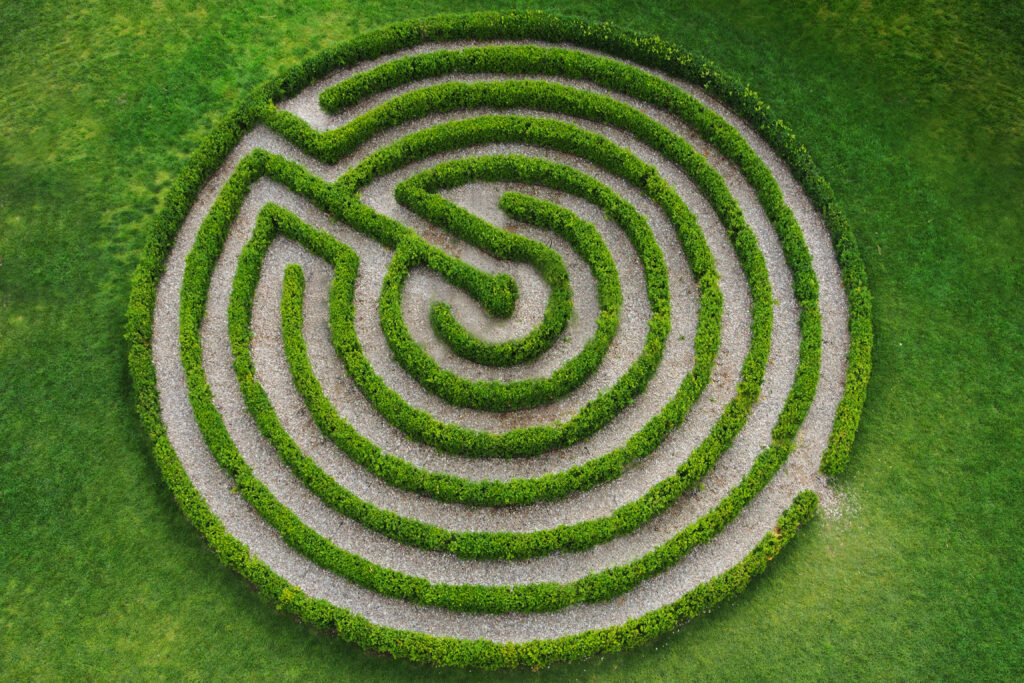This article explores liminality as it is relevant to labyrinths. Implications of the definition of liminality and the two- or three-dimensionality of labyrinths is discussed. A taxonomy of the labyrinth walking process is presented. The article concludes with a brief consideration of the liminal significance of the Knossos Labyrinth’s location on the island of Crete.
This 40-page pamphlet addresses a broad spectrum of ages and environments, including public, private, parochial, and Montessori classrooms. Activities include ways to use labyrinths in math, language, history, science, music, movement, and art, as well as in celebrations and sensory experiences.
These comments were written for a presentation to a church labyrinth committee in Bloomington, Indiana. They describe the labyrinth as a spiritual aid, a form of pilgrimage, building community and both traditional and contemporary.
There is an emphasis on written work when supporting the development of reflective skills in undergraduate students. This conference abstract describes and evaluates the use of labyrinth walking on a canvas, as a strategy to promote the skills necessary for reflection. An on-line questionnaire was used to seek students’ views on the labyrinth experience. The introduction of labyrinth walking was considered a useful tool for facilitating reflection and self-awareness.
The purpose of this Master of Science research project is to understand the creative process of designing and constructing a labyrinth on private property in the United States. How might the creative person be impacted by an intrinsically motivated and seemingly individualistic effort? This exploration has revealed that this unique experience of designing and building a labyrinth is one of self-observation, self-discovery, and personal growth.
In this article, labyrinth walking is explored as one of several reflective practices that may assist health professionals in learning about and managing the emotional impact of illness experiences, the healing process, and provider-patient relationships. This article proposes understanding reflection as a complex, three-level process and identifies dimensions which differentiate a variety of reflective process activities.
This article presents labyrinth walking and mandala creation as personal growth processes that are showing therapeutic promise for reducing anxiety and depression and enhancing wellbeing. Labyrinth walking has been likened to a moving meditation and mandala drawing has been shown to support self-reflection, integration and to reduce anxiety. Thirteen participants in a morning’s labyrinth walk and mandala drawing program were asked to complete questionnaires about their experiences of the processes. Two main themes of journeying and appreciating time out for self-reflection emerged. Overall participants found all stages of the program protocol supportive, with most appreciation expressed for the mandala creation, the walking and the group sharing.
This paper explores how a constructivist approach uses the selective integration of narrative therapy, client-generated metaphors, and expressive therapeutic arts. Finger labyrinths were used to help clients focus.
This literature review describes the physiological and psychological effects of labyrinth walking and and addresses three research questions. First, how is labyrinth walking defined, and what are its key features? Second, what is the focus of the literature about labyrinth walking? Third, what are the physiological and psychological effects of labyrinth walking? The literature review finds that the literature about labyrinth walking focuses minimally on the physiological effects and almost exclusively on the psychological effects. Two qualitative questions that should be answered by future studies are why people enjoy labyrinth walking and whether the labyrinth walking motivates people to achieve higher levels of physical activity.
In this study of individuals with COPD, participants were randomly assigned to a mindful meditation group and a waitlist control group. The labyrinth was one of several mindfulness techniques introduced to the mindful meditation group. The results are inconsistent and vary depending on participation rates; however, this study does demonstrate that mindfulness meditation is feasible and potentially beneficial among those with COPD. This is a Master of Social Work field practicum report.






